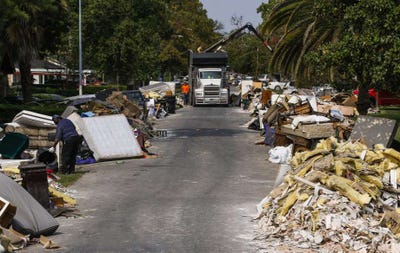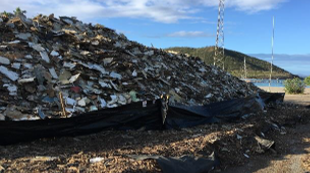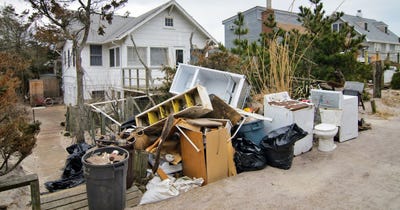Disaster Recovery Pros Cash in on Storm-Aftermath Debris

In 2019 alone about 18 hurricanes and major storms ripped through regions from New England and the Gulf Coast to Bermuda, leaving considerable cleanup work for disaster recovery companies like Ceres Environmental Services, DRC Emergency Services, and LILMO Marine Services.
These operations aren’t just landfilling debris that ends up stranded on land and water or left at the curb. They are retrieving what has value, processing and selling it to recyclers.
Their success through hurricanes, tornadoes, wildfires and ice storms depends on quick action, clear communication and public education. And it depends on special skills to safely manage materials that sometimes could otherwise harm the environment and public.
 Just after a major weather event, Sarasota, Fla.-based Ceres Environmental spends extensive time educating the public on how to put materials out for collections.
Just after a major weather event, Sarasota, Fla.-based Ceres Environmental spends extensive time educating the public on how to put materials out for collections.
“If it’s properly segregated at the curb it helps us move faster and increases the likelihood that we can recycle it. And if we can recycle metals, household hazardous wastes (HHW) and large appliances, in particular, that goes a long way in saving money. Otherwise it costs us more to sort than to landfill,” says Karl Dix, director of client services, Ceres Environmental Services.
Materials like petroleum, pesticides, oils, and lubricants are collected on separate trucks and hauled to debris management sites with designated areas for HHW.
“We store it in a safe way, and that’s where our mission ends and the U.S. Environmental Protection Agency (EPA) has a contractor take it from that point to categorize, label, collect, containerize and move materials for recycling or disposal,” says Kerry Kennedy, Ceres project manager.
With appliances there’s more to Ceres’ role than collection and storage. The team removes Freon and other possible contaminants and may shrink wrap the units to prevent coils from hanging out and the escape of Freon. Ceres hauls them for crushing and baling if they contain no refrigerants, which are EPA-regulated hazardous materials.
Refrigerators or freezers with putrid foods are put in child’s pools because they are cheap, large enough to control what may spill, and can be disposed of easily.
Stranded vehicles are a big market. Ceres hauls them to storage sites with labeled lanes and labeled parking spots.
 “We keep a roster of all vehicles, makes, and models because we give the opportunity for local law enforcement to contact residents to see if they want them back, or have their insurance company come out to do an assessment. Though most likely it’s totaled if we towed it,” says Kennedy.
“We keep a roster of all vehicles, makes, and models because we give the opportunity for local law enforcement to contact residents to see if they want them back, or have their insurance company come out to do an assessment. Though most likely it’s totaled if we towed it,” says Kennedy.
Ceres removes oil, fuel and batteries, then sends the vehicle to metal recyclers who remove plastics, leather seats, and other parts and then crush the metal to go into other products.
Kennedy was in the Virgin Islands during Hurricanes Irma and Maria, and he and his team processed plenty of boats.
If a boat or vehicle is submerged in water, a marine salvage contractor may pull it out with a spud barge, which is stabilized with poles, then a diver goes down and rigs the unit, which is lifted with a crane or knuckle boom.
Once they are on land, Ceres removes electronics, oils, petroleum, lubricants, metal, and lead and processes them for recycling. Engines are drained, and an EPA contractor takes them for recycling. All that’s left at that point is the fiberglass hull, which Ceres shreds and landfills.
“When managing many of these materials, we have to be very careful to protect workers, the public and the environment. For example, with boats we put down a layer of mulch in the working area to collect spillage and protect the ground. When shredding fiberglass, we continuously wet down debris to keep the particles down, and we run air monitors on site to ensure safe air quality,” says Kennedy.
LILMO Marine Services, based out of Cape Coral, Fla., has pulled entire houses from canals.
Wayne Bauer, owner of LILMO Marine Services, recalls busy times during Hurricane Ike, recovering high-end beach houses that were lifted from their stilts, floated across the intercoastal, and landed on levies.
“Many of these homes had minimum damage, but we had to demolish them because the cost to transport them and put them on stilts again was more than the cost of the homes. Some had no windows broken and even elevators intact. So, I dismantled them, removed appliances, shutters, awnings, gutters, air conditioning units, even window frames and anything we could recycle,” says Bauer.
 He sold the materials to local scrap yards. Most of what had resale value was metals, which recyclers separated and melted down to make new products.
He sold the materials to local scrap yards. Most of what had resale value was metals, which recyclers separated and melted down to make new products.
Some waste streams are put to rather creative uses. Asphalt shingles can be crushed and used to fill potholes for local governments. Vegetation can be reduced and used as biofuel at cogeneration facilities. Paper companies sometimes use mulch from knocked down trees to make paper, while farmers spread it in their fields, and landfills have used it in caps.
DRC Emergency Services provides multiple post disaster emergency services to 250 government clients across the country. Its main focus is debris collection, processing, disposal and recycling.
“The driving force behind these contracts is early preparation. It eliminates the need for jurisdictions to go through the procurement process in their time of need,” says Mark Stafford, vice president of Response and Recovery at DRC Emergency Services.
DRC moves quickly to train clients on post-disaster processes and to contract for critical infrastructure and storage needs for recovered materials.
“For car and vessel removal and recycling we sometimes find and permit aggregation sites for clients, but if they have municipal property that is ideal, we will save time and use it,” says Stafford.
DRC’s two landmark projects were after Hurricanes Ike and Katrina.
After Hurricane Ike in 2008, DRC ran a vessel recycling program for the state of Texas and recovered over 200 boats; brought them to the aggregation site; removed fluids and hazardous material; and for commercial cargo vessels extracted many other materials.
The company did similar work throughout Louisiana after Hurricane Katrina in 2005, both with vessels and vehicles.
“There is a metal market and there will always be a market for metals, so it’s an easy deal. Though value is affected by market conditions,” says Stafford.
However, he would never count solely on opportunities to recover recyclables after major weather events for his bread and butter.
“If you look at subcontractors where the need is most prevalent, they salvage as a larger part of their business. This has to be one component of an array of services,” says Stafford.
DRC, like similar companies, is able to take on opportunities as they arise by subcontracting to local companies that do recovery work, negating the need to stock a large inventory of tow boats and salvage equipment.
The company has done only small recovery projects since Ike and Katrina. But, says Stafford, “I anticipate continuous streams of storms and would expect to have more activities in all areas of debris removal, including marine and land salvage of recoverable and recyclable materials.”
About the Author
You May Also Like




.png?width=300&auto=webp&quality=80&disable=upscale)